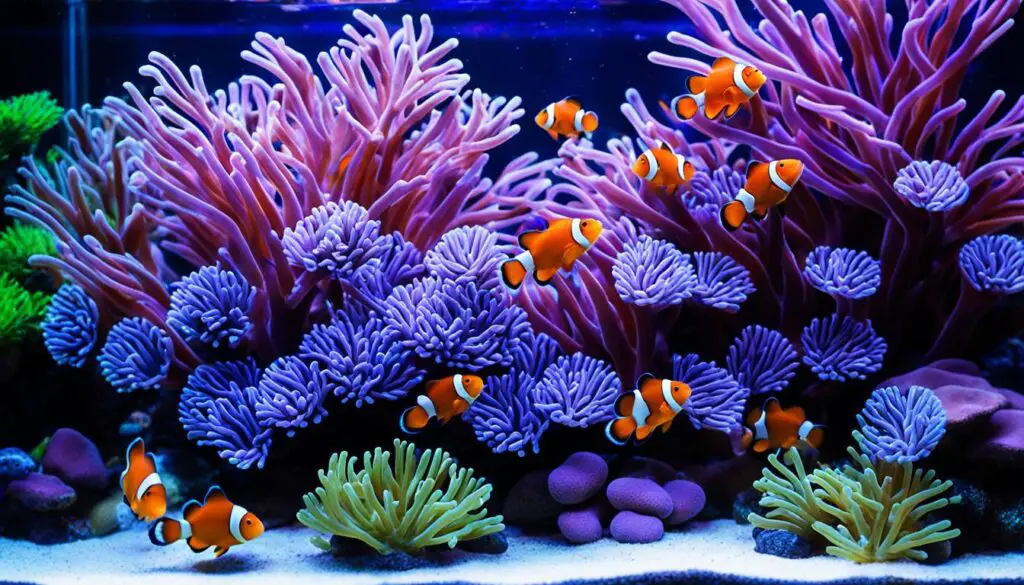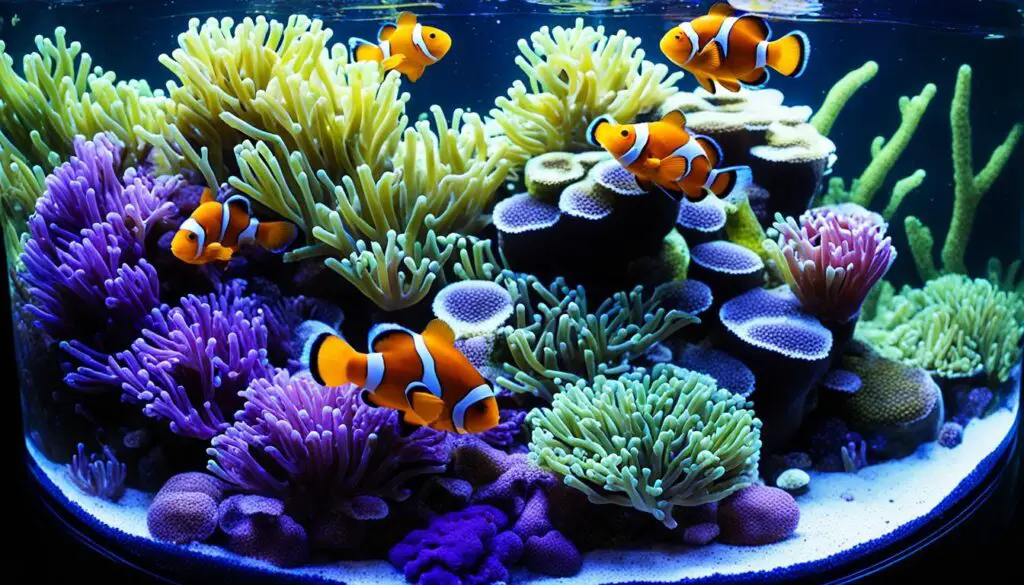What Is The Climate For Coral Reefs
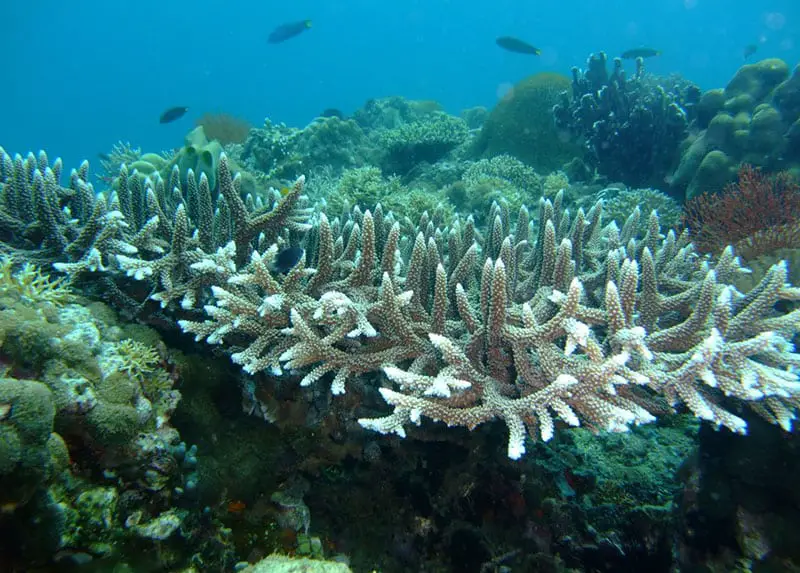
Introduction
What Is The Climate For Coral Reefs: Coral reefs, often referred to as the “rainforests of the sea,” are among the most diverse and ecologically vital ecosystems on our planet. These underwater wonderlands are found in tropical and subtropical regions where the climate is a critical factor influencing their existence and health. Understanding the climate for coral reefs is essential for preserving these delicate ecosystems and the countless species that rely on them for survival.
Coral reefs thrive in warm, sunlit waters, typically in regions with temperatures ranging from 20 to 32 degrees Celsius (68 to 89.6 degrees Fahrenheit). The sun provides the energy necessary for the growth of the symbiotic algae called zooxanthellae, which live within the coral polyps and provide them with nutrients through photosynthesis.
Climate change poses a grave threat to coral reefs. Rising sea temperatures can lead to coral bleaching, a process where corals expel their zooxanthellae, resulting in a loss of color and often, death. Additionally, ocean acidification caused by increased levels of carbon dioxide in the atmosphere can weaken coral skeletons, making them more susceptible to damage from storms and other environmental stressors.
In this exploration of the climate for coral reefs, we will delve deeper into the environmental conditions that sustain these remarkable ecosystems, examine the challenges they face due to climate change, and explore the vital role they play in supporting marine biodiversity and human well-being.
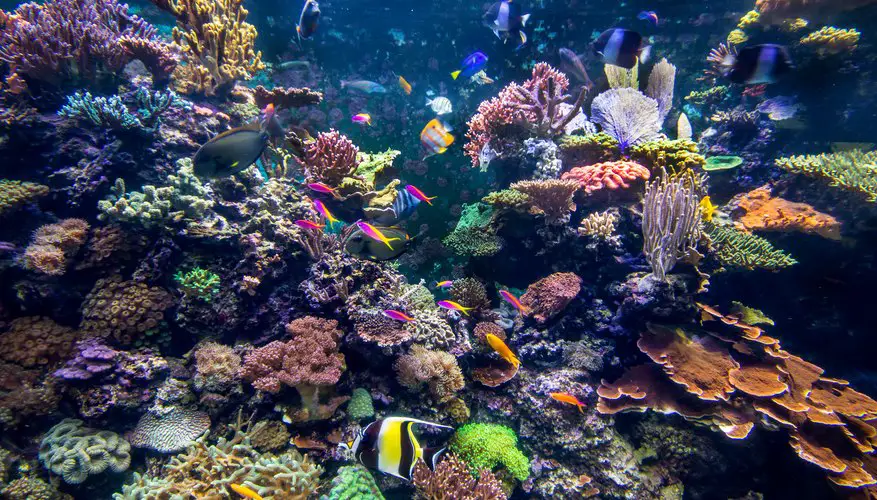
What is the climate and locations of coral reefs?
Coral reefs are found in shallow water where sea surface temperatures range from 68° F to 97° F. More than 90 percent of the world’s coral reefs occur in the Indo-West Pacific biogeographic region. Reef systems also can be found in the West Atlantic, East Atlantic, and East Pacific oceans between 30° N and 30° S.
Coral reefs are exquisite underwater ecosystems found in specific climate and geographic conditions. The climate and locations of coral reefs are intimately intertwined, as these environments are highly sensitive to their surroundings.
Coral reefs primarily thrive in tropical and subtropical regions, characterized by warm waters with temperatures ranging between 20 to 32 degrees Celsius (68 to 89.6 degrees Fahrenheit). These regions receive ample sunlight, a crucial factor for the survival of the symbiotic algae known as zooxanthellae.
Geographically, coral reefs are typically situated in clear, shallow waters near coastlines. They are prevalent in the Western Atlantic/Caribbean, the Indo-Pacific, the Red Sea, and the Great Barrier Reef off the northeastern coast of Australia. The Pacific Ocean’s “Coral Triangle” is renowned for its extraordinary biodiversity and is often referred to as the epicenter of coral reef diversity.
The combination of warm water, sunlight, and relatively low nutrient levels in these regions provides the ideal conditions for coral reef growth and sustenance. However, these ecosystems are fragile and highly susceptible to environmental changes, including rising sea temperatures, ocean acidification, and pollution, making their conservation crucial to preserving marine biodiversity and the well-being of coastal communities worldwide.
Are coral reefs warm or cold?
Not all corals live in warm water – in fact, over half of all known coral species are found in cold, deep, and dark waters.
Coral reefs thrive in warm tropical waters, typically found in regions where temperatures range between 73 and 84 degrees Fahrenheit (23 to 29 degrees Celsius). These ecosystems are predominantly associated with tropical and subtropical climates, encompassing a vast expanse of the world’s oceans. In such environments, corals form intricate colonies, creating the diverse and vibrant ecosystems we recognize as coral reefs.
The warmth is crucial for the survival of the corals themselves, as they have a symbiotic relationship with tiny photosynthetic algae called zooxanthellae. These algae reside within the coral’s tissues, providing them with essential nutrients through photosynthesis. Consequently, coral reefs are predominantly found in areas where sunlight and warm water are abundant.
Conversely, cold-water corals, as the name suggests, inhabit cooler oceanic regions, typically at depths beyond the reach of sunlight. These corals are specially adapted to thrive in colder temperatures, often in the range of 39 to 59 degrees Fahrenheit (4 to 15 degrees Celsius). They can be found in regions like the North Atlantic and certain parts of the Southern Ocean.
How does climate change corals?
Rising (or even falling) water temperatures can stress coral polyps, causing them to lose algae (or zooxanthellae) that live in the polpys’ tissues. This results in “coral bleaching,” so called because the algae give coral their color and when the algae “jump ship,” the coral turns completely white.
When corals experience prolonged exposure to elevated temperatures, they expel the symbiotic algae living within their tissues, which provide them with essential nutrients. This expulsion results in the coral turning white, hence the term “bleaching.” Without these algae, corals become weakened and more susceptible to disease, making their long-term survival uncertain.
Climate change also contributes to ocean acidification. The excess carbon dioxide (CO2) in the atmosphere dissolves in seawater, leading to a decrease in pH levels. This increased acidity makes it harder for corals to build their calcium carbonate skeletons, crucial for their structural integrity and growth.
Rising sea levels, another consequence of climate change, can reduce the light available to corals, hindering their ability to photosynthesize. Additionally, more intense storms and hurricanes, exacerbated by warmer ocean temperatures, can physically damage reefs.
Overall, climate change disrupts the delicate balance that sustains coral reefs, putting these invaluable ecosystems and the myriad species that depend on them at risk. Urgent global efforts to reduce greenhouse gas emissions and implement conservation measures are essential to safeguard the future of coral reefs.
Why are coral reefs important to the climate?
Coral reefs protect coastlines from storms and erosion, provide jobs for local communities, and offer opportunities for recreation. They are also are a source of food and new medicines.
Coral reefs play a crucial role in the Earth’s climate system and are important for several reasons:
- Carbon Sink: Coral reefs absorb and store large amounts of carbon dioxide (CO2) from the atmosphere. The process of calcification, where corals build their calcium carbonate skeletons, removes CO2 from the water. This helps mitigate climate change by reducing the concentration of greenhouse gases in the atmosphere.
- Biodiversity and Ecosystem Services: Coral reefs are incredibly biodiverse ecosystems, providing habitat and sustenance for countless marine species. The health of these reefs is intertwined with the overall balance of ocean ecosystems, influencing fish populations and the global food chain. A healthy reef system helps support fisheries, which are essential for many coastal communities.
- Coastal Protection: Coral reefs act as natural barriers, protecting coastlines from erosion and storm damage. They absorb wave energy and reduce the impact of storms, making them a crucial defense against coastal hazards, particularly in vulnerable regions.
- Tourism and Economy: Coral reefs contribute significantly to the tourism industry. Tourists flock to destinations with vibrant reefs for snorkeling, diving, and other recreational activities, injecting revenue into local economies and providing livelihoods for countless people.
- Scientific Research: Coral reefs offer valuable insights into the effects of climate change, including ocean acidification and rising sea temperatures. Researchers study these ecosystems to better understand their responses to environmental stressors and develop strategies for conservation.
Where do coral reefs grow?
The majority of reef building corals are found within tropical and subtropical waters. These typically occur between 30o north and 30o south latitudes. The red dots on this map show the location of major stony coral reefs of the world.
Coral reefs, often referred to as the “rainforests of the sea,” thrive in warm, shallow waters of the world’s oceans, typically in tropical and subtropical regions. These unique and vibrant ecosystems are found in a variety of locations, with specific conditions necessary for their growth:
- Tropical Oceans: Coral reefs are most commonly found in the warm waters of the tropical and subtropical regions, primarily between 30 degrees north and south of the equator.
- Shallow Waters: Coral reefs require sunlight for the photosynthesis of the symbiotic algae (zooxanthellae) that provide them with essential nutrients. Hence, they predominantly grow in shallow waters, typically less than 100 feet (30 meters) deep.
- Clear Water: Coral reefs thrive in areas with clear, nutrient-rich water. Clear water allows for sufficient light penetration, while nutrient-rich conditions support the growth of the corals and the diverse marine life they host.
- Calm Conditions: Reefs also benefit from relatively calm waters as strong wave action can damage the delicate coral structures. Natural barriers like lagoons, islands, and coastlines often provide protection.
- Specific Locations: Notable coral reef regions include the Great Barrier Reef in Australia, the Coral Triangle in Southeast Asia, the Caribbean Sea, and the Red Sea, among others. Each of these areas offers unique biodiversity and ecological significance.
Unfortunately, coral reefs are increasingly threatened by factors such as climate change, ocean acidification, pollution, and overfishing, which are causing widespread coral bleaching and reef degradation. Protecting these vital ecosystems is crucial for preserving marine biodiversity and the well-being of coastal communities that depend on them.
Are there regions where coral reefs are more resilient to climate change?
Coral reefs are vital marine ecosystems that face unprecedented threats from climate change, including rising sea temperatures, ocean acidification, and more frequent and severe storms. However, research has shown that there are regions where coral reefs exhibit higher levels of resilience to these stressors.
One such region is the Coral Triangle, located in the western Pacific Ocean and encompassing waters around Indonesia, Malaysia, the Philippines, Papua New Guinea, the Solomon Islands, and Timor-Leste. This biodiversity hotspot boasts some of the most resilient coral reefs on the planet. Its remarkable resilience can be attributed to various factors, including its high species diversity, complex ecosystem interactions, and relatively stable climate patterns.
Another resilient coral reef region is found in the northern Red Sea. Here, coral reefs have demonstrated an ability to withstand extreme temperature fluctuations, potentially due to their adaptation to the naturally warm and saline conditions of the area.
Moreover, certain remote and less-impacted reefs in the Pacific and Indian Oceans have shown greater resilience due to reduced human disturbance.
Understanding these resilient regions is crucial for developing conservation strategies and assisting other vulnerable coral reef ecosystems. However, the overall prognosis for coral reefs remains grim unless global efforts to combat climate change and reduce local stressors are significantly escalated.
What can individuals do to help protect coral reefs from climate-related threats?
Individuals play a crucial role in safeguarding coral reefs from climate-related threats. Firstly, raising awareness is paramount. By educating themselves and others about the intricate ecosystems of coral reefs and their vulnerability to climate change, individuals can inspire collective action. This can be achieved through social media, community workshops, or supporting organizations dedicated to reef conservation.
Reducing carbon footprint is another pivotal step. Simple lifestyle changes such as using energy-efficient appliances, opting for sustainable transportation, and minimizing waste can significantly mitigate the impacts of climate change on coral reefs. Moreover, advocating for policies that prioritize renewable energy sources and carbon emissions reduction is vital at a local and global level.
Engagement in responsible tourism is crucial. Snorkeling and diving enthusiasts can choose operators who adhere to sustainable practices, like avoiding physical contact with corals or using reef-friendly sunscreen. Supporting marine protected areas and participating in reef clean-up initiatives also contribute to the preservation of these delicate ecosystems.
Finally, supporting scientific research and conservation efforts financially or through volunteer work aids in understanding and addressing the specific challenges faced by coral reefs. By taking these collective actions, individuals can become powerful advocates for the protection of these invaluable underwater wonders in the face of climate-related threats.
What other climate-related threats do coral reefs face?
Coral reefs face a multitude of climate-related threats beyond just rising temperatures. Ocean acidification is a significant concern. As carbon dioxide levels rise in the atmosphere, a portion is absorbed by the oceans, leading to a decrease in pH levels. This acidification inhibits the ability of corals to build their calcium carbonate skeletons, making them more vulnerable to damage and erosion.
Another critical threat is coral bleaching. This occurs when corals expel the colorful algae living within their tissues due to stress from elevated sea temperatures. This process leaves them stark white and highly susceptible to disease and mortality. With global temperatures on the rise, bleaching events are becoming more frequent and severe, leaving reefs less time to recover.
Intensified storms and cyclones also pose a threat. These extreme weather events can physically break apart coral structures and disrupt the delicate balance of reef ecosystems. Additionally, sea-level rise contributes to the overall stress on reefs, as it can lead to reduced light penetration and increased sedimentation.
Pollution from land-based sources exacerbates the challenges faced by coral reefs. Runoff carrying agricultural chemicals, sewage, and plastic waste can lead to poor water quality and foster the growth of harmful algae, further compromising the health of corals.
Addressing these multifaceted threats requires concerted global efforts to reduce greenhouse gas emissions, implement sustainable land-use practices, and establish effective marine protected areas. It is imperative that we act swiftly to safeguard these invaluable ecosystems and the myriad species that depend on them.
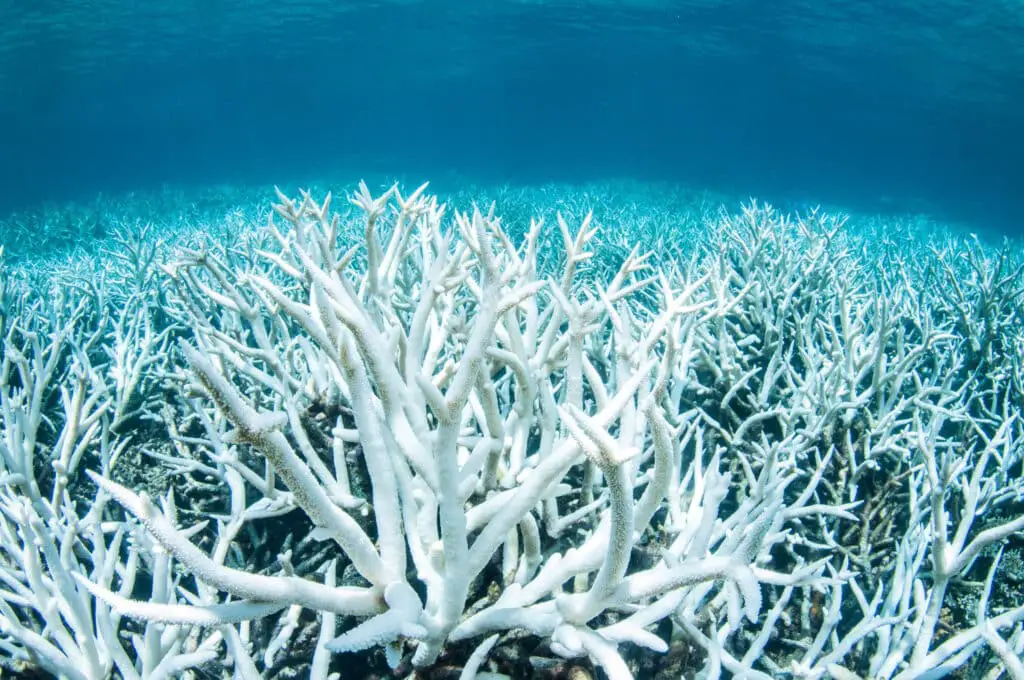
Conclusion
The climate for coral reefs is a complex and finely tuned system, vital for the survival of these remarkable underwater ecosystems. Coral reefs, teeming with diverse marine life, depend on specific environmental conditions to thrive.
However, the climate for coral reefs is under dire threat, primarily due to human-induced climate change. Rising sea temperatures driven by global warming lead to coral bleaching events, which can result in catastrophic consequences for these delicate organisms.
Preserving the climate for coral reefs is not just an ecological imperative but also a matter of global importance. Coral reefs serve as crucial nurseries for countless marine species, supporting fishing industries and coastal communities.
To safeguard these irreplaceable ecosystems, concerted global efforts are needed. Mitigating climate change, reducing pollution, and establishing marine protected areas are essential steps. Only through collective action can we hope to maintain the climate for coral reefs and ensure that these awe-inspiring underwater worlds continue to thrive for generations to come.


